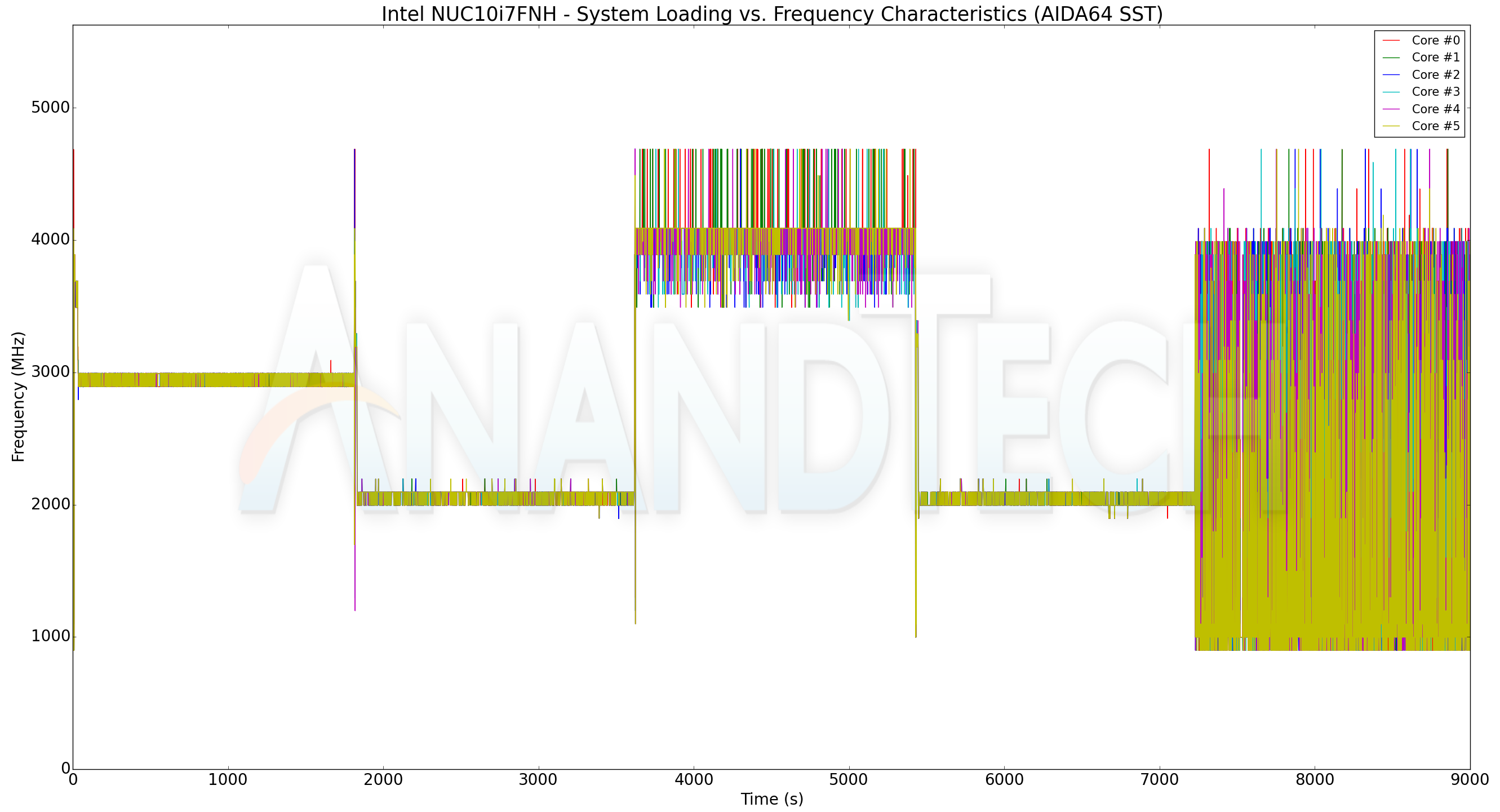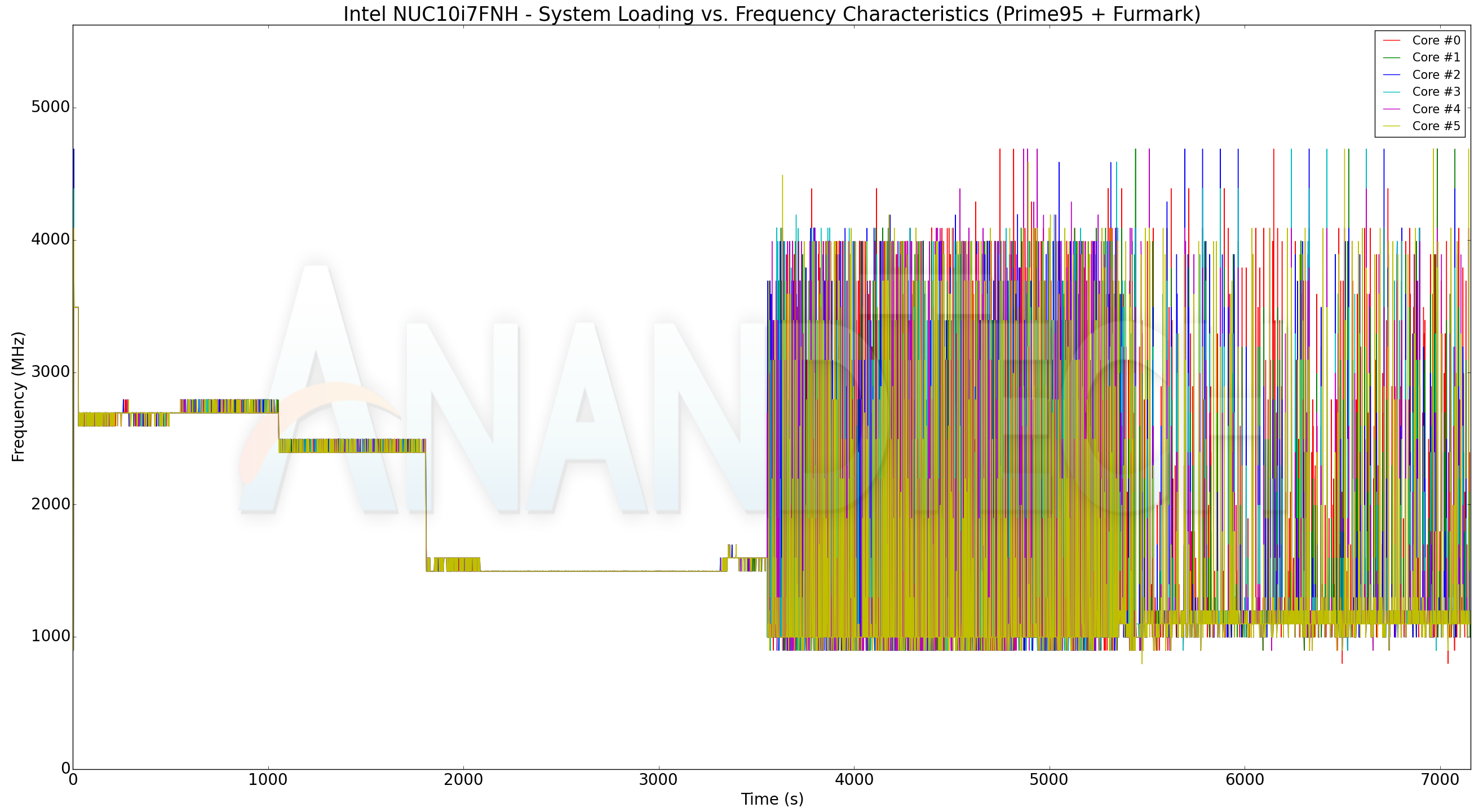Intel NUC10i7FNH Frost Canyon Review: Hexa-Core NUC Delivers a Mixed Bag
by Ganesh T S on March 2, 2020 9:00 AM ESTPower Consumption and Thermal Performance
The power consumption at the wall was measured with a 4K display being driven through the HDMI port. In the graphs below, we compare the idle and load power of the Intel NUC10i7FNH (Frost Canyon) with other low power PCs evaluated before. For load power consumption, we ran the AIDA64 System Stability Test with various stress components, and noted the maximum sustained power consumption at the wall.

The usage of a PCIe 3.0 x2 NVMe SSD along with a low TDP processor (25W, compared to the 28W+ processors in the other systems, other than the June Canyon NUC) manufactured in a highly-optimized and power-efficient 14nm process result in the Frost Canyon NUC having a sub-5W idle power consumption even while driving a 4K display. The system is able to sustain 90W+ at the wall for a very brief duration only, with the power falling slightly south of 60W for sustained workloads.
Our thermal stress routine starts with the system at idle, followed by four stages of different system loading profiles using the AIDA64 System Stability Test (each of 30 minutes duration). In the first stage, we stress the CPU, caches and RAM. In the second stage, we add the GPU to the above list. In the third stage, we stress the GPU standalone. In the final stage, we stress all the system components (including the disks). Beyond this, we leave the unit idle in order to determine how quickly the various temperatures in the system can come back to normal idling range. The various clocks, temperatures and power consumption numbers for the system during the above routine are presented in the graphs below.
| Intel NUC10i7FNH (Frost Canyon) System Loading with the AIDA64 System Stability Test | |||

The frequencies adjust to ensure that the 30W PL1 is maintained. With just the CPU loaded, the cores can maintain around 3 GHz sustained. Adding the GPU brings the CPU cores down to 2 GHz. With only the GPU stressed, the CPU cores can stay close to their boost clocks without consuming much power. The thermal design is quite good, with the package temperature never above 90C for extended durations.
| Intel NUC10i7FNH (Frost Canyon) System Loading with Prime95 and Furmark | |||

Our custom stress test with Prime95 and Furmark shows similar characteristics. Frequencies get adjusted to maintain a 30W package power, and the package temperature does not cross 85C. Furmark loads the GPU more than the AIDA stress component, and hence, we see the CPU frequency drop down to around 1.5 GHz in this case.










85 Comments
View All Comments
HStewart - Tuesday, March 3, 2020 - link
I will say that evolution of Windows has hurt PC market, with more memory and such, Microsoft adds a lot of fat into OS. As as point of sale developer though all these OS, I wish Microsoft had a way to reduce the stuff one does not need.Just for information the original Doom was written totally different to games - back in old days Michael Abrash (a leader in original game graphics) work with John Carmack of Id software for Doom and Quake, Back then we did not have GPU driven graphics and code was done in assembly language.
Over time, development got fat and higher level languages plus GPU and drivers. came in picture. This also occurred in OS area where in 1992 I had change companies because Assembly Language developers started becoming a dying breed.
I think part of this is Microsoft started adding so many features in the OS, and there is a lot of bulk to drive the windows interface which is much simpler in older versions.
If I was with Microsoft, I would have options in Windows for super trim version of the OS. Reducing overhead as much as possible. Maybe dual boot to it.
HStewart - Tuesday, March 3, 2020 - link
I have some of original Abrash's books - quite a collectors item now a dayshttps://www.amazon.com/Zen-Graphics-Programming-2n...
HStewart - Tuesday, March 3, 2020 - link
And even more - with Graphics Programming Black book - almost $1000 nowhttps://www.amazon.com/Michael-Abrashs-Graphics-Pr...
Qasar - Tuesday, March 3, 2020 - link
you do know there are programs out there that can remove some of the useless bloat that windows auto installs, right ? maybe not to the extent that you are referring to, but ot is possible. on a fresh reinstall of win 10, i usually remove almost 500 megs of apps that i wont use.erple2 - Saturday, March 14, 2020 - link
This is an age old argument that ultimately falls flat in the face of history. "Bloated" software today is VASTLY more capable of the "efficient" code written decades ago. You could make the argument that we might not need all of the capabilities of software today, but I rather like having the incredibly stable OS's today than what I had to deal with in the past. And yes, OS's today are much more stable than they were in 1992 (not to mention vastly more capable)Lord of the Bored - Thursday, March 5, 2020 - link
My recollection is that was Windows Vista, not XP. XP was hitting 2D acceleration hardware that had stopped improving much around the time Intel shipped their first graphics adapter.Vista, however, had a newfangled "3D" compositor that took advantage of all the hardware progress that had happened since 1995... and a butt-ugly fallback plan for systems that couldn't use it(read as: Intel graphics).
And then two releases later, Windows 8 dialed things way back because those damnable Intel graphics chips were STILL a significant install base and they didn't want to keep maintaining multiple desktop renderers.
...
Unless the Vista compositor was originally intended for XP, in which case I eat my hat.
TheinsanegamerN - Monday, March 2, 2020 - link
you dont need a 6 core CPU for back office systems or report machines either. So they wouldnt buy this at all.Dell, HP, ece make small systems with better CPU power for a lower price then this. The appeal of the NUCs was good CPUs with iris level GPUs isntead of the UHD that everyone else used.
PeachNCream - Monday, March 2, 2020 - link
The intention of the NUC was to provide a fairly basic computing device in a small and power efficient package. Iris models were something of an aberration in more recent models. In fact, the first couple of NUC generations used some of Intel's slowest processors available at the time. timniva - Tuesday, March 3, 2020 - link
The point is that if you're making a basic computing device why even go beyond 4 cores. I kind of want a NUC as a basic browsing computer that takes up little space. I can see these being used in the office too. Many use cases for a device like this with 6 or more cores in the office, especially for folks in engineering fields running Matlab or doing development/compiling. However, in almost all of these use cases having a stronger graphics package helps, never mind gaming. Taking a step back in the GPU side, especially given what AMD is doing right now and this being in response to the competition, doesn't make much sense. Perhaps this is just to hold them over until Intel fully transitions to using AMD GPUs in the future?Lord of the Bored - Thursday, March 5, 2020 - link
Can I just say how much I love that four cores is now considered a "basic" computing device? It leaves me suffused with a warm glow of joy.